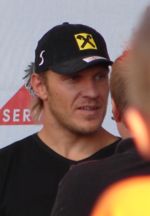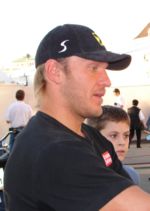Hermann Maier
2008/9 Schools Wikipedia Selection. Related subjects: Sports and games people
Hermann Maier (born December 7, 1972, Altenmarkt im Pongau) is an Austrian skier who has won four overall World Cup titles (1998, 2000, 2001, 2004), two Olympic gold medals (both in 1998), three World Championship titles (1999: 2, 2005: 1) and 53 races in the World Cup. He ranks among the likes of Jean-Claude Killy, Ingemar Stenmark, Toni Sailer, Alberto Tomba, Kjetil André Aamodt and Franz Klammer as one of the best exponents of the sport.
Maier did not initially enjoy much success in skiing. As a 15-year old at the Schladming ski academy, he was sent home after being told he wouldn't make it because of his slight build caused by growth impairments. He returned home to his father's ski school in Flachau, which is still Maier's hometown. He took up work as a bricklayer in the summer and a ski instructor in the winter.
Participating in local races, Maier became a multiple regional champion in Salzburg and Tyrol, but still was not able to gain a spot in the strong Austrian World Cup skiing team. Putting that behind him, his outstanding talent was recognized for the first time by Austrian coaches in 1996, when he was timed with the 12th fastest time in a World Cup giant slalom in Flachau, although only starting as a forerunner and not participating in the actual competition. This would become the starting point of his international career. In 1997 he won his first World Cup event - a super-G race in Garmisch-Partenkirchen, Germany. He quickly established himself as an explosive and dynamic skier, well known for his strength, his willingness to take risks and the endless effort he put into his training sessions.
Since then he has dominated the sport, winning the gold medal in the giant-slalom and super-G at the 1998 Winter Olympics in Nagano only a few days after a dramatic crash in the downhill race, which put him on the cover of the American sports magazine Sports Illustrated and made him a well known sportsman around the globe. In the same year he won the super-G World Cup and the overall World Cup. He went on to the win the overall World Cup in 2000 and 2001.
His career seemed over after a near-fatal motorbike accident in August 2001, colliding with a car on his way home from a summer practice session. Doctors were close to amputating his leg, but instead Maier underwent massive reconstructive surgery. Many thought his career was over, and he had to sit out the 2001-2002 and 2002-2003 seasons and missed the 2002 Winter Olympics in Salt Lake City.
However, Maier returned to the World Cup in January 2003 in Adelboden, Switzerland. He shocked the skiing world with an amazing super-G victory in the skiing-mecca of Kitzbühel, Austria only two weeks later. 2003-2004, in his first full season back, he won the super-G World Cup and the overall competition for the fourth time in his career, a feat widely seen as one of the greatest comebacks in sports history. In 2004 Hermann Maier received the Laureus World Sports Award for the "Comeback of the Year".
Reflecting his apparently indestructible nature, he is sometimes jocularly known as "The Herminator". After his Olympic gold medals in Nagano he also appeared on Jay Leno's Tonight Show on NBC - together with Austrian-born actor Arnold Schwarzenegger, who is known worldwide as " The Terminator".
In 2004, Maier wrote an autobiography with his friend and former publicity agent, Knut Okresek. The German language book, Hermann Maier: Das Rennen Meines Lebens, dealt mainly with his stunning recovery from the 2001 motorcycle accident. In 2005, VeloPress, a Boulder, Colorado based publisher affiliated with Ski Racing magazine, acquired the worldwide English language rights to the book, which was published in time for the 2006 Olympics in Turin, Italy, as Hermann Maier: The Race of My Life.
In October 2005, winning the giant slalom in Sölden, he reached 51 victories in the World Cup, which makes him the fourth-best alpine-skier of all time behind Ingemar Stenmark, Annemarie Moser-Pröll and Vreni Schneider.
On June 20th 2006, he announced he was switching to HEAD as his equipment sponsor, leaving his long time sponsor Atomic.
On January 18th 2008, he was ranked second in the Kitzbühel's super-G only behind Marco Büchel. His career result in Kitzbühel's super-Gs is incredible and the best in history (in just 7 participations he made incredible 5 wins and 2 second places). Day later, he was fifth in Kitzbühel's downhill. These achievements are his best results of the 2007/08 season yet.
World Cup victories
Overall
| Season | Discipline |
|---|---|
| 2004 | Overall |
| 2004 | Super-G |
| 2001 | Overall |
| 2001 | Downhill |
| 2001 | Super-G |
| 2001 | Giant Slalom |
| 2000 | Overall |
| 2000 | Downhill |
| 2000 | Super-G |
| 2000 | Giant Slalom |
| 1999 | Super-G |
| 1998 | Overall |
| 1998 | Super-G |
| 1998 | Giant Slalom |
Individual victories
Downhill
Giant slalom
Besides skiingHermann also won an all-around sports competition, the 2001 edition of the American Superstars competition. |

